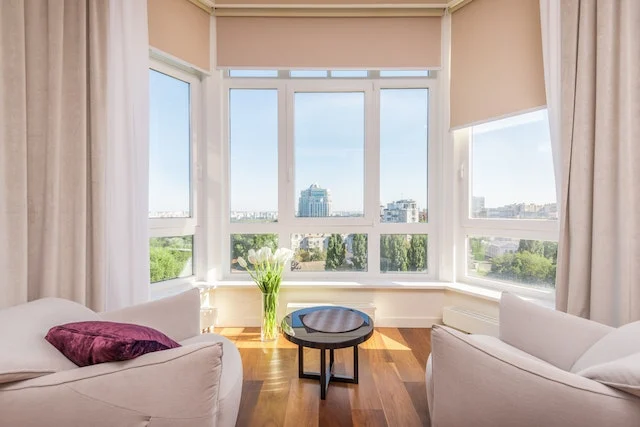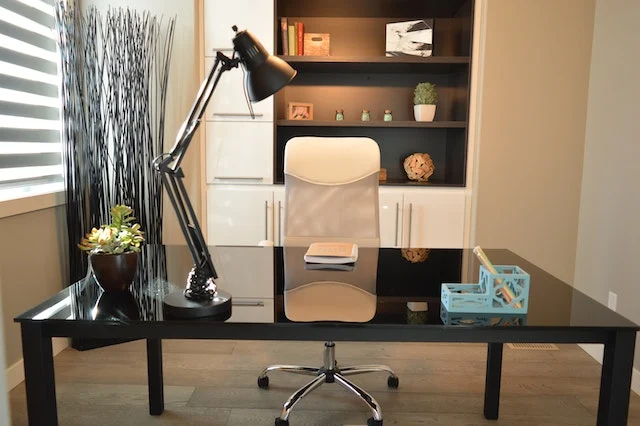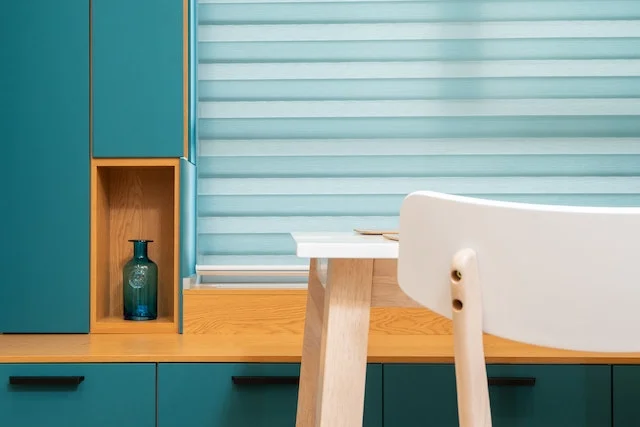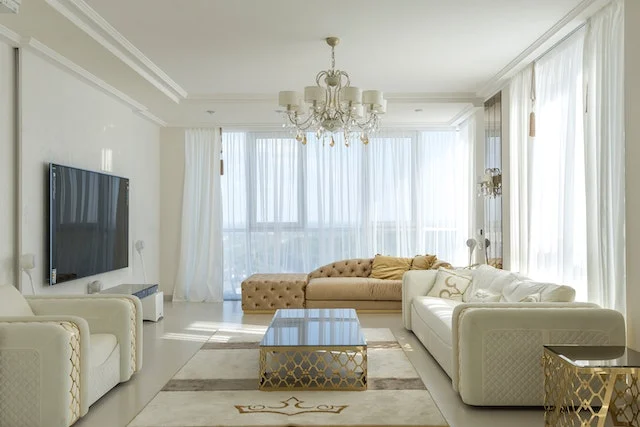Looking for the best type of blinds for your home office? Blinds are a great way to add personality and privacy to your space, but what type is best for you? In this article, we’re going to cover the different types of office blinds, their benefits, and which one is best for you.
When selecting the best blinds for a home office, you need to consider light and privacy (and budget of course). There are many types of blinds, overall the best type for a home office is drapes. They are the most versatile option for any home office to maximize light and privacy with a moments adjustment to adapt to all scenarios.

When you think of an office, often the first thing that comes to mind is a sterile, white space with nothing but desks and computers. But there’s no need to be limited by this traditional image – in fact, some offices have taken advantage of the modern trend of decorating with natural materials like wood or plants. So if you’re thinking of adding some curtains to your office space, here are five ways to go about it!
Types of window treatments
1) Curtains
Curtains are a type of fabric that can be used to divide rooms or to provide privacy. They are often made from a variety of materials, including cotton, linen, and silk. Curtains can be used in offices, homes, and other places. They can also be used to improve your work environment.
Why put them in an office?
Yes, it is possible to put curtains in an office. Curtains are a great way to create privacy and add style to your office while designing your home office. They can also help keep the room cooler in summer or warmer in winter.
Before you buy curtains for your office, make sure to measure the windows and find the right size. You’ll also want to consider the color of the curtains and whether you want them tie-dye or solid. Finally, choose a curtain fabric that will be compatible with your décor. Mixing too many textures is not ideal.
If you have any questions about putting curtains in your office, don’t hesitate to ask a decorator or call a professional window coverings company on your area. It is often worth the investment in time and money. A properly decorated space wil truly change your mindset and productivity.
Do you want your office to look more inviting and comfortable? Putting curtains in your office can do just that. Not only will they add visual appeal, but they can also block out distractions and help you focus on your work. Plus, who knows — maybe they’ll make you more productive!
There are a few things to keep in mind when putting curtains in an office. First, make sure the fabric is lightweight so it doesn’t make noise when the wind blows. Also, choose a curtain length that’s appropriate for the space. And finally, be sure to get creative and mix and match different curtain styles to create a cohesive look.
Benefits of putting curtains in an office
There are many benefits to putting curtains in an office, both for the employees and the office itself. Happy employees are more productive, here’s why!
One benefit is that it can help to reduce noise levels. Curtains can help to block out sound from the outside world, which can be helpful if you have a busy office and you want to keep your employees quiet. It can also help to reduce distractions, which can be helpful if you need your employees to focus on their work.
Another benefit of curtains is that they can improve air circulation. When it’s hot outside, closing off windows and doors can make it even hotter inside. Adding curtains can help to circulate air, which can be helpful in cool weather or during periods of high humidity. It also helps to avoid unpleasant smells from circulating into the office.
Overall, adding curtains in an office can be a beneficial way to improve both the appearance and the function of the space.
Can you put curtains in an office?
Yes, you can! Curtains can be a great way to add personality and flavor to your office, while also keeping you comfortable during the summer months. Curtains are also a great way to block out sunlight and other distractions. If you’re looking for ideas on how to style your office with curtains, check out our blog section below!

Cost of curtains
The cost of curtains is something to consider when deciding to put curtains up or not. Curtains can be expensive, depending on the size and style. A basic set of curtains can cost around $60, and can be a good option for smaller offices. Larger offices may need more than one set of curtains, and may end up costing around $300. Making curtain a good option for the best type of blinds for home office.
Putting curtains in an office can be a great way to create a more relaxing and comfortable work environment. Not only will those working feel more at ease, but their productivity will likely increase as well. Consider putting up some sheer curtains to allow natural light in during the day and bring in the night with blackout shades for a restful sleep.
2) Blinds
Types of Blinds
1) Horizontal Blinds
For smaller windows horizontal blinds allow a lot of flexibility and adaptability with light. You can direct the slats to optimize light, all while maintaining a level of comfort and privacy at all times throughout the day. Either by raising it partially or completely, you can even further levels of control.

2) Vertical Blinds
For larger windows or patio doors, floor to ceiling vertical blinds are the way to go. Much like horizontal blinds they are composed of slats, which benefit from the same flexibility and adaptability to different suitable lighting conditions throughout your working hours for your home office.
3) Roller Blinds
Roller blinds allow for less flexibility with light and privacy, they can only be lowered or raised, there are no individual slats that can be used to further adjust light. Roller blinds are ideal for people looking for an budget friendly and low maintenance solutions to blinds for a home office.

4) Zebra Blinds
Zebra blinds combine a benefits of curtains and blinds into one product. The slats can be rotated to allow the most possible light into the room and only acting as a privacy barrier. They can also be fully rotated vertically, as seen below, to reduce the amount of light.

5) Roman Shades
Roman shades are often the least expensive solution to covering your windows. They are a simply fabric with little internal mechanism to function. Much like it’s more expensive counterparts (roller blinds & zebra blinds), they can only be raised or lowered.

3) Slats/Shutters
This is the most expensive way of covering your windows. However, they are one of the most sophisticated ways to do so. With a modern and complete design they can truly bring an entire room together., especially a home office. Although, they have a larger price tag, they are not most versatile option to control light and privacy.

4) Drapes
Our pick for the best type of blind for a home office is drapes! They can be combined as shown below with a white silk like fabric (a sheer curtain) with an opaque fabric (a black out curtain). Here’s a great resource to learn more. This allows for maximum versatility with light and privacy adjustments. If you want a lot of light and care less about privacy, then you pull back both curtains. If you want light but privacy, then only use the sheer curtain.

5) Electronic Blinds
Corded/Plug-In Blinds:
These are the most popular types of blinds, and they come in a variety of shapes and sizes. To install them, you simply unplug the cord from the wall, and then push the blinds up and over your window. They’re a great option if you want something simple and easy to use.
Wireless Blinds:
Wireless blinds are similar to corded/plug-in blinds, but they use radio frequencies instead of cables. This means they can be controlled using a remote control or an app on your phone. They’re perfect if you want to be able to adjust the settings without having to get up from your desk. What better way to wake up in the morning and press a button to open all the window coverings allow all of the golden morning light to enter!
Considerations for home office Blinds
When it comes to choosing the best type of blinds for a office, there are a few things to consider.
First and foremost, you’ll want to think about how much natural light you want to allow in. If you have mostly bright windows, then vertical blinds might be the best option for blocking out sunlight while letting in light during the morning and early evening. If, however, you have mostly dark windows, then a horizontal blind might be a better choice.
Next, think about what kind of look you’re going for. If you want a sleek and modern look, then lattices or Roman shades are a great option. If you prefer a more traditional look, then roller shades or Venetian blinds are probably the way to go.
Finally, keep in mind your budget. While high-end options may be more visually appealing and efficient at blocking out sunlight, they may also cost more money. Try to find something that fits both your needs and your budget before making your purchase.

How to Measure for Blinds
When it comes to purchasing blinds for your office, there are a few things you’ll need to take into account. First and foremost, measure the width and height of your windows. Secondly, consider the type of window treatment you’re looking for. Below we’ll outline some of the most common types of blinds, and give you tips on how to measure for them.
How to Install Blinds
When it comes to installing blinds, there are a few things to keep in mind.
First and foremost, the size of the window is important. Generally speaking, smaller windows will require shorter blinds than larger windows.
Secondly, the type of material that the blinds are made from is also important. faux wood blinds will block more light than metal or wood blinds will. Finally, any cords or wires that run through the window should also be considered when selecting your blinds.
Tips for using best type of Blinds in a home Office
Blinds can be a great way to add privacy and acoustics to your office space. However, there are a few things to keep in mind when choosing them.
First, the size of the window should play a major role in your decision. If the window is small, artificial blinds are likely the best option. However, if the window is large, you may want to look into natural or plantation style blinds. Another factor to consider is whether you want your blinds to be open or closed. If you want them closed all the time, choose opaque blinds; on the other hand, if you only want them opened for certain times of the day, opt for translucent blinds.
If you’re using blinds in an office setting, it’s also important to keep in mind the environment. Consider factors such as room temperature and light levels. If your office gets too cold at night or during winter months, make sure to invest in thermal blinds. And if your office is always very bright during the day, consider purchasing blackout curtains or shades.
Conclusion
This detailed list of window coverings and treatments allows you to compare all of your options for your home office when deciding what type of blinds are best for a home office. Keep in mind nothing is permanent! You can always start with a cheap alternative such as roman curtains and make your way to wireless zebra blinds!















